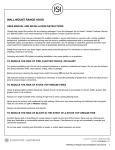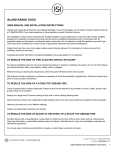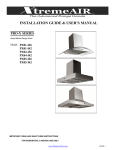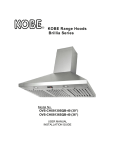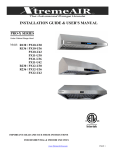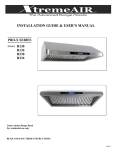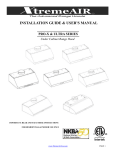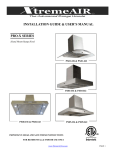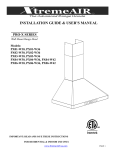Download USER & INSTALLATION MANUAL
Transcript
USER & INSTALLATION MANUAL MODEL(S) KH 300 KH 360 CAREFULLY READ THIS USER MANUAL BEFORE USING 1 CONTENTS READ AND SAVE THESE INSTRUCTIONS ....................................................... 3 INSTALLATION .................................................................................................... 5 OPERATION INSTRUCTIONS .......................................................................... 11 SPECIFICATIONS ............................................................................................. 14 HOOD DIMENSIONS ......................................................................................... 14 ELECTRICAL DIAGRAMS ................................................................................. 15 TROUBLESHOOTING ....................................................................................... 16 2 IMPORTANT SAFETY INSTRUCTIONS WARNING: TO REDUCE THE RISK OF INJURY TO PERSONS IN THE EVENT OF A RANGE TOP GREASE FIRE, OBSERVE THE FOLLOWING: To Reduce The Risk Of Fire Or Electric Shock, Do Not Use This Fan With Any Solid-State Speed Control Device. 1. Installation work and electrical wiring must be done by a qualified person(s) in accordance with all applicable codes and standards, including fire-rated construction codes and standards. 2. When cutting or drilling into a wall or ceiling, be careful not to damage hidden electrical wiring and other utilities. 3. Before servicing or cleaning the unit, switch power off at the service panel and lock the service disconnection to prevent power from being switched on accidentally. When the service disconnection cannot be locked, securely fasten a prominent warning device, such as a tag, to the service panel. 4. Don’t get the power lines restructured, stretched, connected, imposed with weights or pinched etc. The power lines can be easily damaged leading to electrical shock or fire. 5. It is prohibited to change the internal wiring of the range hoods without authorization; it may result in abnormal functioning which may lead to personal injury. Improper maintenance may lead to electric shock and fire. Ducted fans must always be vented to the outdoors. Clean all grease laden surfaces frequently. To reduce the risk of fire and to disperse air properly, make sure to vent air outside. DO NOT vent exhaust air into wall spaces, attics, crawl spaces or garages. NOTE: If there is no invoice issued by the authorized agency or the damage of the components is due to misuse, improper installation, improper use, improper handling, negligence or other uncontrollable factors by our authorized agency, warranty services cannot be obtained. Any maintenance done without the consent of our authorized agency will make the warranty card invalid. For any direct or indirect damage caused by our product such as personal property, real property loss and personal injury due to the above mentioned misuse reasons, our company will not be liable. WARNING: TO REDUCE THE RISK OF A RANGE TOP GREASE FIRE 1. Never leave surface units unattended at high settings. Boil-overs cause smoke and grease spills may ignite. Heat oils slowly on low or medium settings. 2. Clean ventilation fans frequently. Grease should not be allowed to accumulate on the fan or filter. 3. Use proper pan sizes. Always use cookware appropriate for the size of the surface element. 4. Always use ventilation when cooking. 3 5. Use high settings on cooking range ONLY when necessary. 6. Do not leave cooking range unattended when cooking. 7. Use this unit only in the manner intended by the manufacturer. 8. Before servicing, switch power off at service panel and lock service panel (if possible) to prevent power from switching on accidentally. What to Do In The Event Of a Range Top Grease Fire SMOTHER FLAMES with a close-fitting lid, cookie sheet, or metal tray, then turn off the burner. BE CAREFUL TO PREVENT BURNS. If the flames do not go out immediately, EVACUATE AND CALL THE FIRE DEPARTMENT. NEVER PICK UP A FLAMING PAN – You may get burned. DO NOT USE WATER, including wet dishcloths or towels to extinguish a grease fire – a violent steam explosion will result. Use a fire extinguisher ONLY if:* (a) You know you have a Class ABC extinguisher, and you already know how to operate it. (b) The fire is small and contained in the area where it started. (c) You have already called the fire department. (d) You can fight the fire with your back to an exit. * Based on “kitchen fire safety tips” published by NFPA CAUTION: Important - Observe all governing codes and ordinances: * For general ventilating use only. Do not use to exhaust hazardous or explosive materials and vapors. * Do not run cord under carpeting. Do not cover cord with throw rugs, runners, or any other coverings. Do not route cord under furniture or appliances. Arrange cord away from high traffic areas and so it will not be tripped over. * Follow the heating equipment manufacturer’s guideline and safety standards such as those published by the National Fire Protection Association (NFPA), and the American Society of Heating, Refrigeration and Air Conditioning Engineers (ASHRAE), and your local code authorities. * To reduce the risk of fire, use only metal ductwork. * Do not let children use the hood unattended. *The temperature of the environment for range hood use should not be higher than 40°C. 4 INSTALLATION Unplug the appliance from the power supply before servicing. NOTE: This procedure will require 2 people for easier installation. Please read all instructions carefully before installing. 1. If you are renovating your kitchen, be careful to protect your range hood. Volatile gases from building materials, dust, paint and coatings can corrode and tarnish the surface of your range hood. Instead, install your range hood after your kitchen renovation is complete. 2. The stainless steel may have very sharp edges; wear protective gloves when removing the range hood for installing, cleaning or servicing. 3. Be careful not to damage any hidden wire sets when drilling into a wall. Unplug the range hood from the power supply before installation; the main power box should be switched off. 4. If it is needed to move the gas stove before installing the range hood, switch off the gas valve entirely before moving the gas stove. 5. Always use a power socket with reliable grounding. Half-way links of the power line, the use of extension cords and multi-port wiring devices may lead to electric shock, plugs and sockets overheating and fire. Make sure the operation is done by professional electricians, and strictly abide by the national and local electric laws and regulations. Switch the power off and take measures to prevent the power switch from automatically tripping before wiring. 6. To ensure a safe and smooth installation, use our accessories for installation and make sure the expansion tube stays closely within the wall hole when installing it. Do not make the drill hole too large; doing so will cause the expansion tube to be loose which may result in accidental damage. 7. Try to make the two sides of the range hood balanced when installing. 8. If there are no abnormal occurrences during a qualified test run after installation, read the instruction manual carefully and keep it in a safe place. 5 The following tools and materials are needed to finish the installation: Electric drill Drill bit Cross head screwdriver Flat head screwdriver Pencil and ruler, to mark the position for installation Pre-Installation Calculations: Stand-alone installation(table 1) SAFETY WARNING THE HOOD MAY HAVE VERY SHARP EDGES; PLEASE WEAR PROTECTIVE GLOVES WHEN REMOVING ANY PARTS FOR INSTALLING, CLEANING OR SERVICING. Preparation before Installation: NOTE: TO AVOID DAMAGE TO YOUR HOOD, PREVENT DEBRIS FROM ENTERING THE VENT OPENING. 6 Determine the installation height of the range hood (refer to figure 1). If there is a gas stove under the range hood, the minimum distance between the cooking area and the hood should be 30". If there is an electric stove under the range hood, the minimum distance should be 24" to 30". Figure 1 Determine the location of the exhaust pipe which discharges to the outside. (Refer to figure 2) A linear and short air outlet can make the range hood work more smoothly. Avoid using too long and too bent of an exhaust pipe, the use of these pipes can affect the performance of the hood and even shorten the service life. Use duct tape to firmly seal the joints of the pipe, make sure the exhaust pipe and the vent outlet are firmly connected. Figure 3 Figure 7 2 Equipment installation: It is necessary to do turn on the range hood and do a test run, to make sure it is working normally. Remove all protective film on the hood before installation. 1. By using the reference of Figure 1 and the measured values on page 14-15, mark four mounting holes and two security holes on the mounting surface of the hood then drill. Firmly embed the expansion pipe (refer to figure 3). 2. Use a cross screwdriver to screw in 4 mounting screws. Note: the distance between the wall and screw is 10mm (refer to figure 4). 3. Hang the hood onto the installed screws with precise alignment to the mounting hole of the hood. 4. Install the hood firmly onto the wall by tightening the four mounting hole screws. 5. For safety, it is necessary to drill in screws in the two security holes and make sure they are tightened. Figure Note: make sure the hood has been installed firmly before letting go. Piping system installation: IMPORTANT:TO REDUCE THE RISK OF FIRE, USE ONLY METAL DUCTWORK. 1. Attach the duct outlet to the range hood. 8 4 2. Attach the exhaust pipe to the duct outlet and use duct tape to firmly seal all the joints. 3. If you are equipped with a chimney, install the chimney according to figure 7. Power source needs to be within 1.5m to the unit. Power Connection: WARNING: Improper grounding can result in the risk of electric shock. Consult a qualified electrician if the grounding instructions are not completely understood, or if doubt exists as to whether the appliance is properly grounded. Do not use an extension cord. If the power supply cord is too short, have a qualified electrician install an outlet near the appliance. The farthest distance between the power line and the power socket should be no more than 59". Make sure the power line has a reliable power supply system (refer to figure 8). After installation, range hood is ready for use. Figure 9 8 Important: the power cord should be replaced by professionals if damaged. GROUNDING INSTRUCTIONS This appliance must be grounded. In the event of an electrical short circuit, grounding reduces the risk of electric shock by providing an escape wire for the electric current. This appliance is equipped with a cord with a grounding wire with a grounding plug. The plug must be plugged into an outlet that is properly installed and grounded. 10 OPERATION INSTRUCTIONS MODEL : KH 300 / KH 360 The range hood has three different power settings with a 3-minute delay off feature and two 12-volt 20-watt halogen lights. The electronic control panel has four function keys: clock, lights, fan speed and power control (on/off). The extra bright LCD display screen shows the operation state at any time clearly. To set the time, press , eight seconds to set the hour. Press After setting the correct hour, press the , or , these three pilot lights will turn on; the LCD clock will flicker with , and the time will increase or decrease with a range from 00 to 23. key within eight seconds, the LCD clock will flicker. Press or , and the minutes will increase or decrease with a range from 00 to 59. After setting the correct time, wait for eight seconds or press the key to exit. (This function cannot be set while the motor is running). On the control panel, press When the motor is running, the to turn the light on. Press again to turn the light off. button will light up. The default wind speed is high, press the power setting by one level. The wind speed is a cyclic system. Pressing , to decrease will change the wind speed under the delay off condition. On the control panel, press to turn on the range hood and start the motor. Press range hood into a three minute delay off. 11 again to set the CARE AND MAINTENANCE WARNING:UNPLUG THE APPLIANCE FROM THE POWER SUPPLY BEFORE SERVICING. * There may be a risk of fire if you do not clean the hood according to the instruction guide. * Protect the motor, keys and other electrical components of the hood from water during cleaning. * DO NOT allow salt solutions, disinfectants, bleaches, or cleaning compounds to remain in contact with stainless steel for extended periods of time. Many of these compounds contain chemicals which may be harmful to the surface of the range hood. Rinse with water after exposure and wipe dry with a clean lint free cloth. * For optimal operation, clean range hood and all baffle/spacer/filter/oil tunnel/oil containers regularly. SAFETY WARNING: NEVER PUT YOUR HAND INTO THE AREA HOUSING THE FAN WHILE THE FAN IS OPERATING. Cleaning Hood Surface 1. Use only mild soap or detergent solutions. Dry surfaces using a soft cloth. 2. If the stainless steel hood looks splotchy, use a stainless steel cleaner to clean the surface of the hood. Avoid getting cleaning solution onto or into the control panel. Follow the directions of the stainless steel cleaner. (Caution: Do not leave on too long as this may cause damage to the hood finish.) Use a soft towel to wipe off the cleaning solution, gently rub off any stubborn spots. Use a dry soft towel to dry the hood. 3. DO NOT allow deposits to accumulate or remain on the hood. 4. DO NOT use ordinary steel wool or steel brushes. Small bits of steel may adhere to the surface. 12 How to Clean the Baffle Filter The spring bracing in figure 9 firmly supports the oil screen on the hood. Refer to figure 10 to remove the oil screen gently. Use a sponge and warm soapy water to wash it, and make sure it is completely dry before putting it back. Figure 9 Figure 10 How to Replace the Light Bulb CAUTION: HALOGEN LIGHT UNIT MAY BE HOT! WAIT UNTIL THE UNIT IS COOL. 1 2 3 4 1. Make sure all controls are off and the range hood is unplugged. 2. Place a flat-headed screwdriver into the groove of the halogen light glass covering and the housing. 3. Pop out the halogen light glass covering. 4. Gently pull out the defective light bulb and discard. Light bulbs should be 12V 20W maximum. 5. Using a cloth, hold the new light bulb and push securely into light socket. 6. Return halogen light glass cover to the housing. 7. Turn range hood ON to test light. 13 SPECIFICATIONS MODEL/SIZE KH 300 / 30" KH360 / 36" INPUT POWER 260W (including the light) VOLTAGE/ AMPERE 110-120V~60Hz /2.1A CONTROLS Electronic Control LIGHTING 12V 2×20W HOOD DIMENSION (W x H x D) KH 300 29.8” × 24.1” ×14.3” KH 360 36” HALOGEN LIGHTS Net Gross KH 300 46 55 KH 360 55 64 WEIGHT (lbs) SPEED Air Capacity (cfm) × 24.1” ×14.3” KH 300 /KH 360 Low Medium High 460 550 660 HOOD DIMENSIONS KH 300 14 KH 360 ELECTRICAL DIAGRAMS 15 TROUBLESHOOTING If you encounter any abnormal behavior, try to troubleshoot it using the following instructions below: Problem Solution Check whether the power is connected or not. If it is connected, check The unit does not turn on. whether other lamps or home appliances which link to the socket are on or not. The range hood vibrates/shakes when operating. Check the installation of the range hood and tighten the mounting base. Check whether the ventilation door is completely open or not. Check whether there is blockage within the exhaust pipe. Check the oil screen. If the oil screen hasn’t been cleaned or changed in a long time, it might be blocked by oil, affecting the air exhaust. Make sure the distance between the range hood and the cooking area is The range hood does not exhaust air properly. 27”-30”, while an island range hood should be 30”-36” inches. Check whether there is blockage in the exhaust pipe. Make sure the size of the exhaust pipe is appropriate for the range hood. The power light is on, but the motor does not work. Try switching the range hood on and off. If it still doesn’t work, it may be the fault of the motor or the operating system. Check whether the light bulb is properly installed. The motor is running, but the power light does not work. Try the light bulb in a working light bulb holder, if the light bulb still doesn’t work, replace the bulb. (Notice: Make sure the power supply to the range hood is cut off when operating). The connection of the exhaust pipe isn’t air tight. Check the installation of the pipes. Cold air gets into the house. Check whether the ventilation door is installed and whether there is clamping stagnation in the installation site that makes the ventilation door not close completely, letting in cold air as a result. Caution: For your safety, all service and inspections should be conducted by trained and qualified professionals. Make sure the unit is disconnected from power supply during maintenance. 16

















